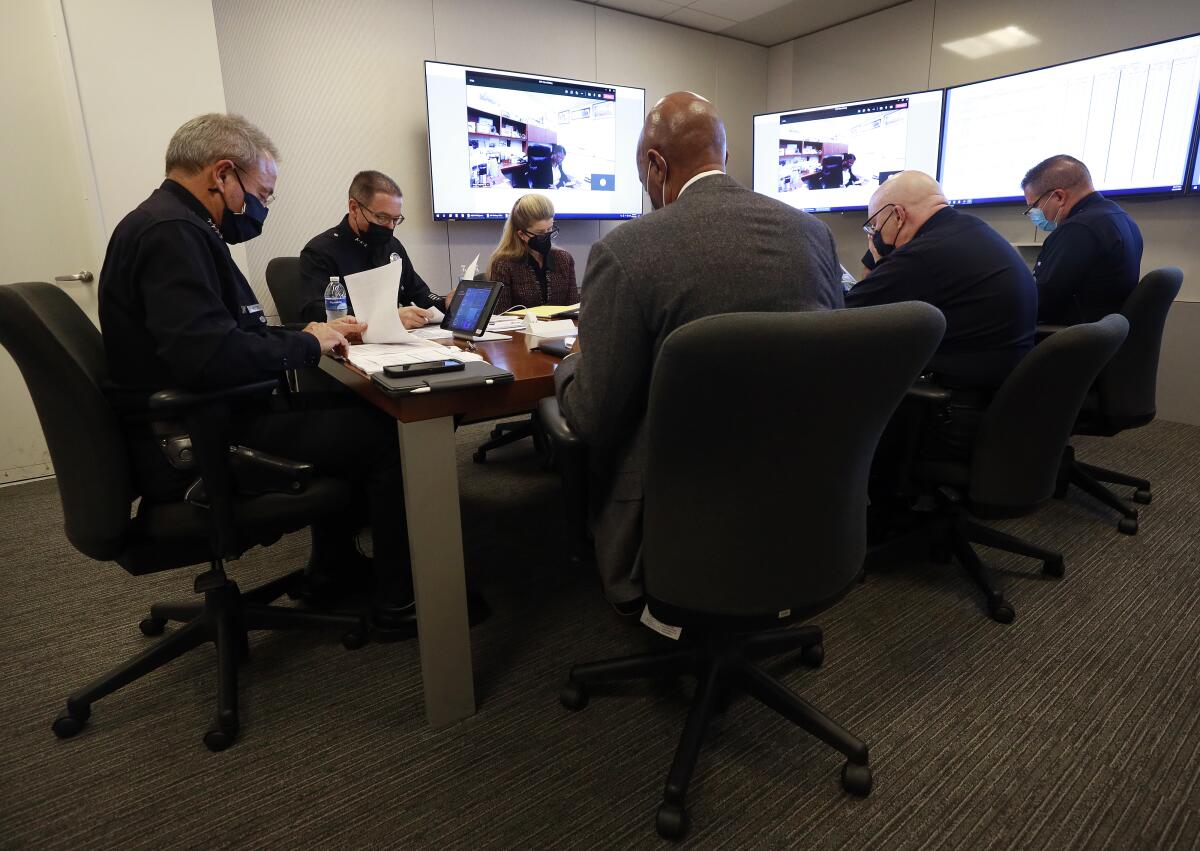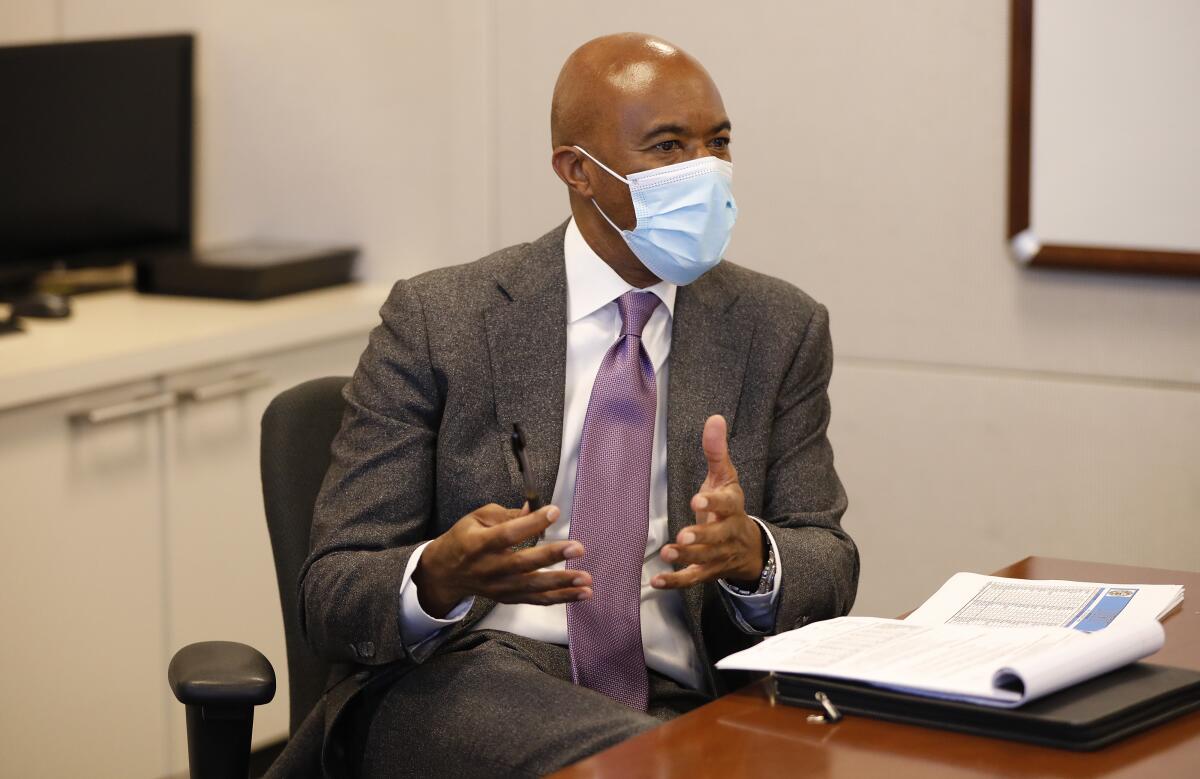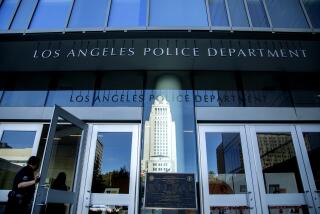Inside an LAPD crime briefing: Homicides, ‘hood days’ and the ‘compounding’ violence

- Share via
In the middle of Los Angeles Police Chief Michel Moore’s command-level crime briefing Monday, Police Commissioner Dale Bonner — who was sitting in on the closed-door meeting — chimed in with a question.
Bonner was looking at printouts of crime figures and wasn’t sure whether the percentages in red ink reflected increases over 2020, when killings and shootings were already elevated, or 2019, before violence spiked in Los Angeles and cities across the country.
Moore made it clear: The increases — including a 17% rise in homicides — were over the 2020 figures. Compared with 2019, Moore said, the uptick was even starker.
“They’re compounding,” Moore said of city killings. “Homicides are up 17%, and people will say, ‘Well, many other cities are actually higher.’ But when we look over a two-year period, they’re up 49%.”
Each Monday, Moore convenes a small group on the 10th floor of LAPD headquarters downtown to go over the latest trends in city crime. The briefing gives Moore a better idea of where the department is making progress, he said, and where it is losing ground.

After a decade of success in driving down violent crime like killings and shootings, Moore and the others in the room have seen the progress fade away since last year, with more and more red ink on their printouts. The latest briefing, which Moore allowed The Times to observe, offered no reprieve.
Walking into the room, each commander — including Assistant Chief Beatrice Girmala, who oversees operations in the department’s four bureaus; Assistant Chief Robert Marino, who oversees special operations; and Moore’s chief of staff, Deputy Chief Daniel Randolph — received charts breaking down crime by geographic area and over time. They also got statistics on crime the department has deemed gang-related, crime linked to the homeless population and crime linked to domestic violence — three categories that have seen upticks in recent years.
Atop their packets was a four-page “Talking Points” document, the first line of which calculated killings.
“There were 10 homicides this past week vs. 3 for the same week last year,” it read.
At the bottom of the page were statistics on shootings. There had been 1,202 shooting victims this year as of the morning briefing, an increase of nearly 20% over the 1,007 at the same point in 2020 and nearly 50% over the 802 at the same point in 2019.
There had been 326 homicides, compared with 277 last year. They included 72 cases in which the victim was homeless — a 33% increase over 2020 — and 35 in which the suspect was homeless.
Of the 10 homicides in the preceding week, Girmala noted, three were cases of domestic violence — reflecting a trend that is drawing concern from officials. Through the end of September, aggravated assaults between intimate partners were up 5.1%.
Between Oct. 22 and Oct. 24, there were 13 shooting incidents in which 16 people were shot; three of them were killed, another sheet in the packet showed. Of those incidents, seven occurred in the LAPD’s South Bureau, four in the Central Bureau and one each in the Valley and West bureaus.
After the group ran through the figures, Bonner asked whether any of the shootings had occurred at the housing developments covered by the department’s Community Safety Partnership program, in which officers get to know the communities in which they work and provide an increased presence in coordination with local leaders.

Moore directed the question to Deputy Chief Emada Tingirides, who was tuning in by video.
“We had no shooting incidents over the past week, Chief,” Tingirides said.
Moore asked Tingirides about her plans for something he said was a significant driver of violence at this time last year: so-called “hood days,” cultural gatherings and homecomings that local gangs hold on the same day each year.
“The phenomenon is real,” Moore said. Tingirides agreed.
Multiple housing developments, including Nickerson Gardens and Imperial Courts in Watts, are expected to see such gatherings in coming days, Tingirides said, and her team was gearing up to be on hand alongside mounted officers and violence intervention workers and peace ambassadors — including from 11 p.m. to 4 a.m., when the events usually peak in size.
“We can get upward of 300 to 500 individuals that don’t necessarily live in the community but come back to the community to oftentimes celebrate or mourn those who have been lost in the community, some to gang violence,” Tingirides said. “Oftentimes there’s a huge issue with parking, with loitering, with gambling, with drinking. We’ve seen violent acts centered around these identified gang neighborhood days.”
Bonner asked whether community leaders were being consulted on possible solutions, and Tingirides said they were. She said her focus recently has been on coordinating with leaders rather than pushing police enforcement as a means of ensuring safety at such events — and it seems to be working.
“This year was a lot better than years past, and I think it’s because that message is out there — that it’s a coordinated effort; it’s not just law enforcement preventing or not understanding what’s going on culturally in those communities,” Tingirides said.
“The key is that we’re not enforcing our way out of this,” Moore said. “The key is the buy-in.”
Moore said the city housing authority and the Mayor’s Office of Gang Reduction and Youth Development will play a role in navigating through the next couple of months, with the goal of preventing gun violence.
The volume of such crime in L.A. this year is already too high.
More to Read
Sign up for Essential California
The most important California stories and recommendations in your inbox every morning.
You may occasionally receive promotional content from the Los Angeles Times.











